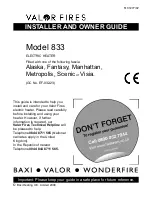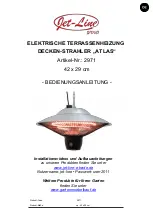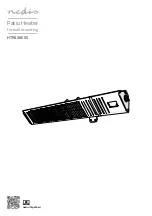
11
Trou
ble
sho
oti
ng
T
ip
s
F.
TROUBLESHOOTING TIPS
F.1 Heater is not operating.
1.
Check all fuses.
2.
Check disconnect switch.
3.
Check voltage supplied to the heater – refer to the heater
data plate for voltage requirements.
4.
Check control voltage if transformer is installed.
5.
Check thermostat by turning it and check continuity.
6.
Check the condition of the disconnect switch if the heater is
so equipped. Measure continuity through the disconnect by
engaging the switch.
7.
Verify that there is a jumper wire present between the
terminals as per the wiring schematics
(refer to Figures
2A – 2F, page 5 – 7.
8.
If problem still exists, contact factory.
F.2 Contactor is chattering.
1.
Check supply voltage.
2.
Check control voltage if transformer is installed.
3.
Check wiring connections. Tighten all loose electrical
connections.
4.
Check thermostat for continuity. If thermostat does not
break continuity replace thermostat.
5.
Check for excessive heater vibration.
6.
Do not operate if problem persists. Contact factory.
F.3 Contactor is burned or welded
1.
Check the contactor for burn marks and blackening. If
present, replace the contactor.
2.
Check incoming power to the heater to ensure there are no
voltage fluctuations.
3.
Check heating element for continuity.
4.
Check motor for continuity.
5.
Check thermostat for continuity. If thermostat does not
break continuity replace thermostat.
6.
Do not operate if problem persists. Contact factory.
F.4 Heater cycles on high limit.
1.
Check the inlet and discharge louvers for air blockage.
2.
Check for heating element fouling.
3.
Ensure motor is functioning.
4.
Do not operate if problem persists. Contact factory.
F.5 Heater is operating but no heat is present.
1.
If equipped with a
“FAN ONLY”
switch, ensure the switch is
in the
“ON”
position.
2.
Check the control voltage to the contactor coil, if unit is
equipped with a contactor and transformer. If voltage is not
within specification replace the transformer.
3.
Verify the contactor coil resistance as per Table 4 –
Resistance Values for Electrical Components, page 11. If
resistance is not within specification replace contactor.
4.
Measure and record all element resistances. Contact
factory to verify if elements are within specifications. If not
within specification replace heating element(s).
5.
If problem persists, contact factory.
F.6 Heater fan does not operate but the heating elements
operate.
1.
Check motor resistance, as per Table 4 – Resistance Values
for Electrical Components, page 11 and ensure fan blade
spins freely to check motor bearings. Replace motor as
required.
2.
Do not operate unit. Contact factory.
Table 4 – Resistance Values for Electrical Components
Item
Description
Ω
Low
Nominal
High
C11055-01
Contactor
0.55
0.58
0.60
TSK4114-32 Transformer
240 V Primary
5.86
6.17
6.48
220 V Secondary
6.56
6.90
7.25
B11033-02
Transformer
480 V Primary
23.73
24.98
26.23
220 V Secondary
6.62
6.97
7.32
B11033-03
Transformer
600 V Primary
36.96
38.91
40.86
220 V Secondary
6.69
7.04
7.39
B11033-04
Transfab
Transformer
480 V Primary
135.21
142.33
149.45
240 V Secondary
43.67
45.97
48.27
B11033-05
Marcus
Transformer
600 V Primary
218.28
229.77
241.26
240 V Secondary
43.28
45.56
47.84
B11033-05
Transfabs
Transformer
600 V Primary
215.14
226.46
237.79
240 V Secondary
39.36
41.43
43.50
B11041-02
GE Motor 208 V - 240 V
45.45
47.84
50.23
B11059-03
GE Motor 480 V
45.45
47.84
50.23
B11059-04
GE Motor 600 V
57.32
60.34
63.36
B11035-03
Thermal Cut-Out
-
0.10
-
Note:
For element resistances, please contact factory.












































